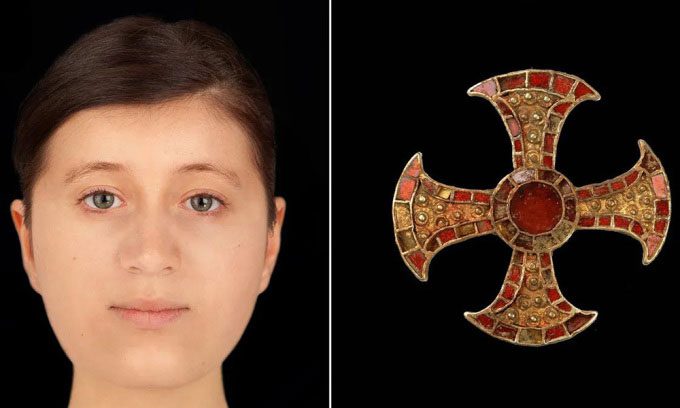Based on skull analysis, experts have reconstructed the face of a 16-year-old noble girl buried in the 7th century following a unique ritual.
A team of experts, including forensic artists, archaeologists, and bioarchaeologists, have reconstructed the face of a 16-year-old girl buried in the 7th century in Cambridge, England, as reported by Interesting Engineering on April 19. The Cambridge Archaeological Unit at the University of Cambridge discovered the bones of this mysterious girl at Trumpington Meadows, a southern suburb of Cambridge, in 2012.

Reconstructed face of the 16-year-old girl with the Trumpington cross. (Photo: Hew Morrison)
To reconstruct the girl’s face, the research team used depth data measurements of soft tissues and skulls specific to Caucasian women. Although they are uncertain about her eye and hair color due to a lack of DNA analysis, they believe the reconstruction provides a good representation of what the girl looked like a few months before her death.
Isotope analysis of her bones and teeth revealed that after the age of 7, it is likely that the girl migrated from a location near the Alps, possibly southern Germany, to England. After arriving in England, her diet significantly decreased. The research team suggests that this dietary change occurred near the end of her life, indicating that the time from migration to death was relatively short.
“The girl was very young when she moved. She likely wasn’t very healthy and had to travel a long way to a completely unfamiliar place, including a different diet. This must have been very frightening,” said Dr. Sam Leggett, a bioarchaeologist at the University of Edinburgh. However, experts have yet to determine the specific cause of the girl’s death despite conducting multiple scientific investigations.
The 16-year-old girl was buried following a unique tradition of “burial on a bed” with an intricately decorated headboard. She was placed on a carved wooden bed, adorned with a gold and garnet cross. Several gold pins and exquisite clothing were also buried alongside her.
The cross is known as the Trumpington cross, one of only five such rare examples found in England. The most famous specimen of this type of cross was discovered in the tomb of St. Cuthbert.
These artifacts indicate that the young girl was likely one of the earliest Christians in England during the 7th century. She probably belonged to the noble class, which is why she was buried with such unique rituals. According to the research team, only 18 such bed burials have been discovered in England to date.
The study of the remains of the 16-year-old girl helps scientists gain a better understanding of human life over a millennium ago and of significant religious phases in Cambridge’s history. The facial reconstruction and other artifacts are expected to be displayed at the Museum of Archaeology and Anthropology (MAA) in Cambridge next year.


















































